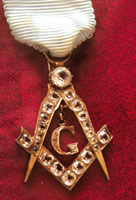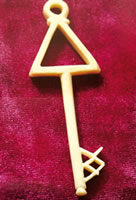Open secrets
Masons have shaped much of Romania's history and become the target of its oppression: a new exhibition shows how they have left their mark on its artefacts
Although cynics may read more than necessary into a fraternity where men aspire to put on long dresses, silk gloves and jewels, Masonry tends to be only an eccentric gentleman's club for networking at a high level.
 Hidden in the cellars of the National History Museum are hundreds of examples of coins, badges and medals which bore masonic symbols, telling an alternative history of the country. The Museum had planned to exhibit these treasures, but whenever the curators raised the issue with their patrons, the Ministry of Culture, they received a blank answer.
Hidden in the cellars of the National History Museum are hundreds of examples of coins, badges and medals which bore masonic symbols, telling an alternative history of the country. The Museum had planned to exhibit these treasures, but whenever the curators raised the issue with their patrons, the Ministry of Culture, they received a blank answer.
“There seemed to be a conspiracy of silence,” said Dr Ernest Oberlander-Tarnaveanu, Chief Keeper of the Coin Room and Historical Treasure and one of the organisers of the exhibition.
But this year the Ministry obliged. There was also interest in a collaboration from the 'Masonic' community of Romania, but the lodges backed away from full support.
Together with broaches, coins and medals, the History Museum has also gathered images of obelisks, compass and squares and Masonic wear to satisfy both enthusiasts of mysterious societies and students of paranoid theories.
Lodges in Romania have dated back to the 18th Century and many masons were key protagonists in the 1848 Romanian Revolution against the Turks, which attempted (and failed) to gain self-definition for the east European nation.
Lodges expanded under the reign of King Carol I and in 1881 Masons established a local branch of the Scottish rite. This is a kind of 'multinational masonic brand', popular in the USA with alumni that include John Wayne, Harry Truman and actor Michael Richards, known for his role as Kramer, the vertical-haired lunatic neighbour of Jerry Seinfeld.
 Until now, the 19th Century was the Romanian Masonic heyday. Figures whom historians call the 'Builders of Modern Romania' were nearly all Masons. These are the men who now appear on the names of Bucharest's streets: Carol Davila, Mihail Kogalniceanu, Ioan Cuza, Ion Ghica, Ion Bratianu, Nicolae Balcescu, Ion Campineanu, Samuel Brukenthal and Dimitrie Cantemir.
Until now, the 19th Century was the Romanian Masonic heyday. Figures whom historians call the 'Builders of Modern Romania' were nearly all Masons. These are the men who now appear on the names of Bucharest's streets: Carol Davila, Mihail Kogalniceanu, Ioan Cuza, Ion Ghica, Ion Bratianu, Nicolae Balcescu, Ion Campineanu, Samuel Brukenthal and Dimitrie Cantemir.
The rise of Fascism and Communism appealed to the populist vein by characterising masons as a self-serving elite working against the common people in the service of a mysterious global plot. This is a prejudice that has yet to abate.
The exhibition shows anti-masonic propaganda from the early 20th century onwards, depicting the lodge members as skeletal reapers spreading apocalypse for cash gains or Jews who stick bull-horns on their face and kill goats for fun.
As the Legionnaires took power in the late 1930s, Romania's Scottish rite dissolved itself and, after a brief resurgence between 1944 and 1948, was crushed by the Communists.
Many masons faced incarceration, while others fled to open lodges-in-exile in France and Israel. Constantin Argetoianu, the last 'Big Chief' of the Masonic Order of Romania, died in prison in 1952.
The 1989 Revolution saw a reflourishing of masonry in Romania. Now there are estimated to be around 2,500 members in 110 lodges throughout the country, according to the Romanian masonic press.
Depending on who you speak to half of the Government and all the senior directors at Romanian-based companies are now illustrious and most powerful masters of the lodge.
Alas this means this intriguing exhibition may become crowded with fortune hunters intent on revising their Masonic know-how so that they can try and break into the elite on the cheap.
Michael Bird
Masonic Medals and Insignias: History and Symbol
'Medalii si insemne masonice. Istorie si simbol'
National Museum of History
Calea Victoriei nr 12
Open unto 31 March
